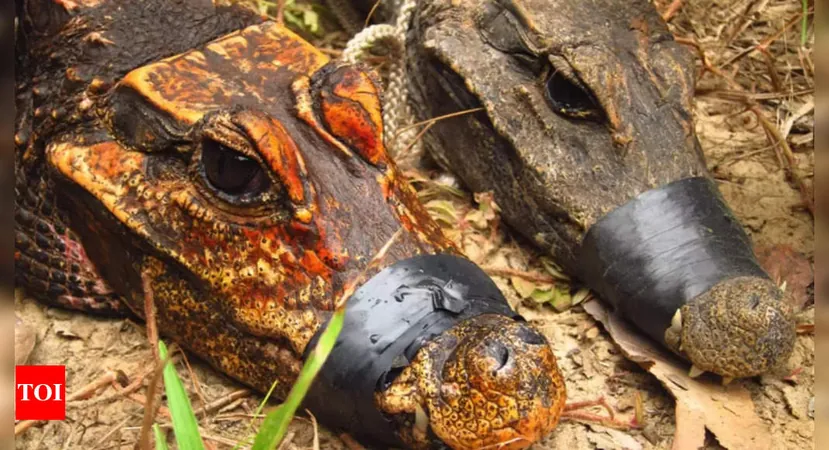
Unbelievable Discovery: Cave-Dwelling Crocodiles Evolving Away from Their Forest Relatives!
2025-01-19
Author: Sarah
In an astonishing revelation from the Abanda Caves in Gabon, scientists have unveiled a unique population of dwarf crocodiles that have been isolated for approximately 3,000 years. These remarkable reptiles have developed extraordinary adaptations to thrive in a world devoid of sunlight, relying on an intriguing diet comprising primarily of bats and crickets.
The Incredible Abanda Caves
Located upstream from the Fernan Vaz Lagoon, the Abanda Caves have become a focal point of biological fascination. First documented by adventurers Dr. Marco Marti and Claude Werotte in the early 2000s, extensive explorations by cavers such as Richard Oslisly and his team unearthed the hidden treasures of this cave complex—crocodiles that have significantly diverged from their forest-dwelling relatives.
A Mysterious and Ancient Existence
Archaeologist Richard Oslisly discovered this extraordinary population of dwarf crocodiles in 2008 while exploring the damp dark chambers of the caves. The findings posit that these crocodiles, isolated for millennia, have undergone evolutionary changes necessary for survival in their unique environment.
While traditional crocodiles bask in sunlight to regulate their metabolism, these cave dwellers have adapted to thrive in perpetual darkness. This remarkable capability speaks volumes about nature's capacity to evolve.
Unique Dietary Adaptations
Notably, the diet of these cave crocodiles starkly contrasts that of their forest-dwelling cousins. With access to light-deprived cave ecosystems, they have shifted from a fish-based diet to a heavy reliance on bats and crickets. This unsurprising twist showcases the crocodiles’ incredible flexibility in hunting and feeding behaviors based on environmental constraints.
Research conducted in 2016 indicated that these cave crocodiles are often in better physical condition compared to those residing in forest habitats. This can be attributed to the abundance of prey and potentially fewer predators in their subterranean world.
Striking Skin Changes and Genetic Evolution
One of the most striking physical characteristics of these cave-dwelling crocodiles is their unusual orange skin. According to Matthew Shirley, a conservation biologist, this coloration may result from prolonged exposure to bat guano, which could lead to a unique chemical bleaching effect.
Genetic analysis of these extraordinary reptiles reveals even more groundbreaking information: they possess a genetic divergence from surface crocodiles. This genetic anomaly is not just a trivial detail; it indicates that these crocodiles may be on a path toward becoming a new species altogether—a process driven largely by their isolation and limited gene flow with outside populations.
As Richard Oslisly emphasized, the genetic characteristics displayed by the cave crocodiles mark them as an isolated group, paving the way toward species evolution. Shirley notes, “They’re in the process of becoming a new species. Whether that happens soon or not is anyone’s guess.”
Key Facts About These Fascinating Creatures
- **Name**: Cave-dwelling dwarf crocodiles (*Osteolaemus tetraspis*) - **Location**: Abanda cave system, Ogooué-Maritime Province, Gabon - **Diet**: Primarily cave crickets and bats - **Unique Features**: These orange dwarf crocodiles navigate their dark world, feast on bats, and are known to swim through liquid guano—a truly bizarre adaptation to life underground!
Conclusion
The discovery of these remarkable cave crocodiles is not just a tale of unique adaptations but also a glimpse into the enigmatic evolution of life. The adaptations witnessed in the Abanda Caves raise questions about how isolation influences genetic divergence and the potential emergence of new species. Nature continues to astound us, making every scientific exploration an exhilarating adventure into the unknown!


 Brasil (PT)
Brasil (PT)
 Canada (EN)
Canada (EN)
 Chile (ES)
Chile (ES)
 Česko (CS)
Česko (CS)
 대한민국 (KO)
대한민국 (KO)
 España (ES)
España (ES)
 France (FR)
France (FR)
 Hong Kong (EN)
Hong Kong (EN)
 Italia (IT)
Italia (IT)
 日本 (JA)
日本 (JA)
 Magyarország (HU)
Magyarország (HU)
 Norge (NO)
Norge (NO)
 Polska (PL)
Polska (PL)
 Schweiz (DE)
Schweiz (DE)
 Singapore (EN)
Singapore (EN)
 Sverige (SV)
Sverige (SV)
 Suomi (FI)
Suomi (FI)
 Türkiye (TR)
Türkiye (TR)
 الإمارات العربية المتحدة (AR)
الإمارات العربية المتحدة (AR)